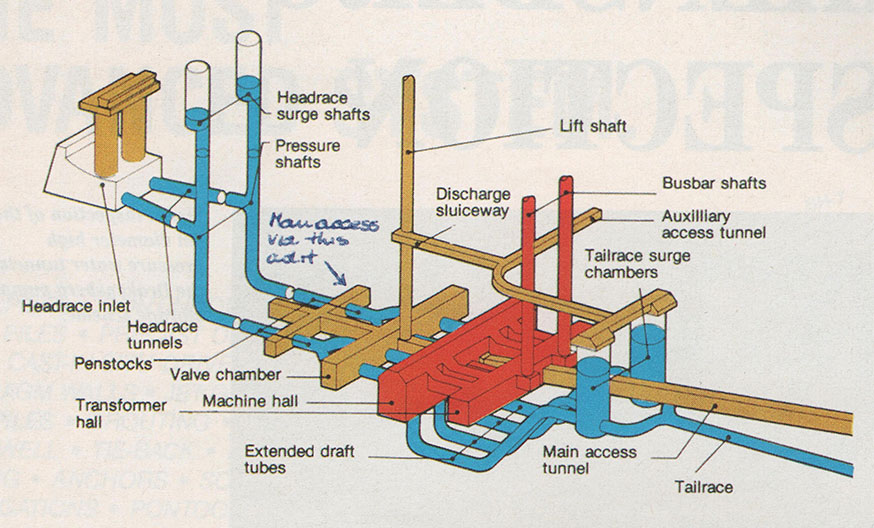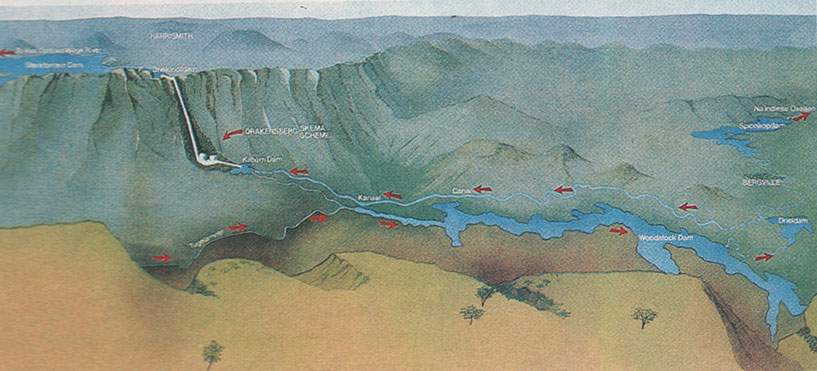Man-entry inspection of Drakensburg penstock Aug 1992
After nine years in service, the high pressure waterway tunnels of the Drakensburg pumped storage scheme in Natal, South Africa, are said to be in remarkably good conditions. During the first man-entry inspection since their commissioning in 1982, convergence readings were taken and the tunnels were visually checked for potentially serious longitudinal cracks in the 750mm think, heavily reinforced concrete lining.
After taking about three days to dewater the system, man access was afforded through massive man holed built in to the 45mm think steel penstocks traversing a construction adit. Once inside, it was possible to walk the 800m to the elbow with the 430m vertical shaft (including the upper 189m of the shaft) and down to the penstock bifurcation and the turbine’s spiral casing.
Being inside what is otherwise a no-go area was an awesome experience, knowing the immense power and energy contained within these tunnels under normal working conditions. Mazimum permissible pressure in the penstocks is 7.2MPa with a maximum flow velocity of 6.4m/sec for the concrete lined sections and 8.4m/sec, increasing to 19m/sec for the steel lined sections. During the inspection, the other half of the system was under full pressure driving two of the station’s four units.
Prestressed lining
The scheme is built in the relatively weak mudstone, siltstone and sandstone of the Drakensberg escarpment. AI; such, As such, the concrete lining of the high pressure tunnels was prestressed to provide the strength required to contain the high static water pressures of up to 50 bar. Transient water hammer pressures due to simultaneous load rejection of the machines adds a further 17 bar pressure at the machines.
Prestressing of the concrete was achieved using a combination of cavity and consolidation grouting followed by interface grouting. Taking into account second order effects, the average strain induced in the lining was specified at 500 microstrain at the upper end of the waterway and 1000 microstrain at the lower. At the time of construction, this level of prestressing was greater than previously attempted anywhere in the world.
Particular attention was also attached to the junction of the concrete lining with the 36mm thick steel lining of the penstocks. "The concrete lining was stressed on to the end of the steel lining to prevent relative movement during operation", said Mike de Witt who was Chief Design Engineer on the project for the consulting JV Gibb Hawkins & Partners. "The joint is thus maintained as watertight as possible and so minimises build up of water pressure external to the steel lining and in the rock upstream of the drainage curtain."
Given the pumped storage nature of the scheme, changes in flow direction significantly increase the abrasive effects of the water on the waterways over those of only generating, one way water flow hydro schemes. This focused attention on the visual aspect of the man-entry inspection.
"Other than very minor repairs to patches in the lining concrete nothing was found to cause concern", said Derek Lee, Chief Consultant (Structural Dynamics) for Eskom, the national electricity utility of South Africa and owner of the 1,000MW pumped storage scheme. The inspection did however identify a defective seal in one of the massive 2.25m diameter spherical penstock shut-off valves, which was repaired during the nine-day shut down in late November 1991.
Power station
The power station (Fig 1), is fitted with four Francis type pump/turbines supplied by Toshiba of Japan and generator/motors from Brown Boveri of Switzerland. The normal generating capacity of each unit is 250MW with 300MW as a maximum. The scheme’s total water flow capacity over the 479m difference in elevation between the upper and lower reservoirs (with an effective pumping height from the base of the turbines in excess of 500m) is 300m3/sec (75m3/sec per unit) for generating and 180m3/sec (45m3/sec per unit) when pumping.
The Drakensberg machines are among the top ten most powerful in the world. The installation can be brought from standstill to full load within three minutes and changed from maximum pumping load to full generation in about eight minutes.
Since being commissioned in 1982, the Drakensberg scheme has performed at its optimum. In addition to performing pumped storage duties for Eskom, the scheme is a vital link in the water supply for Johannesburg and the Pretoria-Witwatersrand-Vereeniging (PWV) Triangle, the interior industrial heartland of South Africa. The Department of Water Affairs pumps constantly about 20m3/sec of water (recently increased from the original 11m3/sec) from the Driel Barrage below the confluence of the Mlambonja and Tugela Rivers into a canal that leads to the Jagersrust forebay dam adjacent to Kilburn Dam, the scheme’s lower reservoir (Fig 2). When the scheme reverts to the pumping mode, it not only lifts its required generating water back up to Driekloof Dam, the upper reservoir, but also pumps water for the Department of Water Affairs. This extra water overflows into the Sterkfontein Dam. From here it is released during water shortages in the Vaal Basin into the Vaal Dam, the primary source of water to the Johannesburg and PWV area.
Water shortage
Critical water shortages in the Vaal Basin over the past decade have placed a high demand on the scheme’s pumping mode. Changes in operating mode have been required by the hour on occasions. According to Bruno Graber, Manager of Hydro and Water Supply Engineering for Eskom, the scheme’s role in augmenting the Vaal Basin water supply was of decisive importance during the recent drought years.
A general shortage of water in the Johannesburg area continues to emphasise the scheme’s pumping capability. In 1992 the scheme provided for the annual transfer of more than 630 million m3 of water, which increases the Vaal’s yield to 2345 million m3 - 52% more than the natural yield.
Relief is on the way with the construction of the Lesotho Highlands Water Project, which is designed specifically to further augment the Vaal supply and meet the ever-increasing demand for water in the Johannesburg area. Phase one of the scheme, programmed to be commissioned in 1996, will transfer an additional18m3/sec of water from rivers rising in the highlands of Lesotho into the Vaal Basin catchment. In the meantime, the Drakensberg installation must continue to support high demands on both its generating and pumping capability.
Active participants in the realisation of the scheme who returned for the first man-entry inspection of the dewatered pressure tunnels included: Bruno Graber who was Project Leader of the scheme during planning, design and construction for Eskom; Ron Hagen who was Construction Supervision Resident Engineer for civil engineering consultants Gibb, Hawkins & Partners, a JV between Sir Alexander Gibb & Partners (UK) and Hawkins, Hawkins and Osborne (South Africa); and David Lawrence who was Chief Civil Engineer for Drakon, the LTA/Shaft Sinkers JV and principal underground excavation contractor. Today, Hagen is Senior Resident Engineer on the Katse Dam construction project as part of the Lesotho Highlands Water Project and Lawrence is Managing Director of Basil Read Mining (Pty) Ltd of South Africa. Mike de Witt is now Director of Ninham Shand and Project Director for Highlands Delivery Tunnel Consultants on the Lesotho Highlands Water Project
It will be some time before the next routine dewatering will present an opportunity to physically inspect the impressive waterways of the Drakensburg scheme once again.
|
|
|
|
|
Add your comment
- Thank you for taking the time to share your thoughts and comments. You share in the wider tunnelling community, so please keep your comments smart and civil. Don't attack other readers personally, and keep your language professional.




